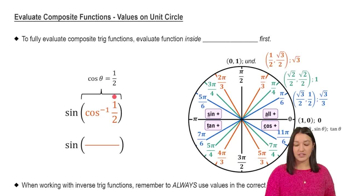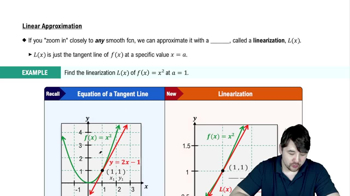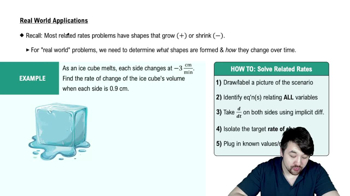Table of contents
- 0. Functions7h 52m
- Introduction to Functions16m
- Piecewise Functions10m
- Properties of Functions9m
- Common Functions1h 8m
- Transformations5m
- Combining Functions27m
- Exponent rules32m
- Exponential Functions28m
- Logarithmic Functions24m
- Properties of Logarithms34m
- Exponential & Logarithmic Equations35m
- Introduction to Trigonometric Functions38m
- Graphs of Trigonometric Functions44m
- Trigonometric Identities47m
- Inverse Trigonometric Functions48m
- 1. Limits and Continuity2h 2m
- 2. Intro to Derivatives1h 33m
- 3. Techniques of Differentiation3h 18m
- 4. Applications of Derivatives2h 38m
- 5. Graphical Applications of Derivatives6h 2m
- 6. Derivatives of Inverse, Exponential, & Logarithmic Functions2h 37m
- 7. Antiderivatives & Indefinite Integrals1h 26m
- 8. Definite Integrals4h 44m
- 9. Graphical Applications of Integrals2h 27m
- 10. Physics Applications of Integrals 2h 22m
4. Applications of Derivatives
Related Rates
Problem 52a
Textbook Question
An angler hooks a trout and begins turning her circular reel at 1.5 rev/s. Assume the radius of the reel (and the fishing line on it) is 2 inches.
a. Let R equal the number of revolutions the angler has turned her reel and suppose L is the amount of line that she has reeled in. Find an equation for L as a function of R.
 Verified step by step guidance
Verified step by step guidance1
Understand that the problem involves a circular motion where the reel is turning, and we need to relate the number of revolutions (R) to the length of the line reeled in (L).
Recognize that each complete revolution of the reel corresponds to the circumference of the circle formed by the reel. The circumference C of a circle is given by the formula: C = 2πr, where r is the radius.
Substitute the given radius of the reel into the circumference formula. Here, the radius r is 2 inches, so the circumference C = 2π(2) = 4π inches.
Since each revolution reels in a length of line equal to the circumference of the reel, the amount of line L reeled in after R revolutions is L = R * C.
Substitute the expression for the circumference into the equation for L: L = R * 4π. Therefore, the equation for L as a function of R is L(R) = 4πR.
 Verified video answer for a similar problem:
Verified video answer for a similar problem:This video solution was recommended by our tutors as helpful for the problem above
Video duration:
2mPlay a video:
Was this helpful?
Key Concepts
Here are the essential concepts you must grasp in order to answer the question correctly.
Circumference of a Circle
The circumference of a circle is the distance around it, calculated using the formula C = 2πr, where r is the radius. In this context, the radius of the reel is 2 inches, so the circumference represents the length of fishing line that is reeled in with each complete revolution of the reel.
Recommended video:

Evaluate Composite Functions - Values on Unit Circle
Linear Relationship
A linear relationship describes how one variable changes in relation to another. In this case, the amount of line L that is reeled in is directly proportional to the number of revolutions R made by the reel, which can be expressed as L = C * R, where C is the circumference of the reel.
Recommended video:

Linearization
Rate of Revolution
The rate of revolution indicates how quickly the reel is turned, measured in revolutions per second (rev/s). Here, the angler turns the reel at a rate of 1.5 rev/s, which helps determine how fast the line is being reeled in over time, linking the concepts of time, revolutions, and the length of line.
Recommended video:

Intro To Related Rates
Related Videos
Related Practice





